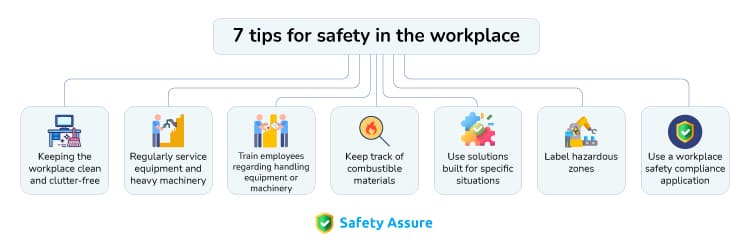In order to run an organization successfully and without hiccups, one of the rudimentary but essential tasks is to ensure a safe workplace for employees. Not ensuring workplace safety has a number of consequences for both the employees and the organization. Employees can get ill or injured on the job which might incur long-term effects, while the organization involved could face OSHA violations leading to penalties, loss of goodwill, administrative costs, and higher employee turnover. Thankfully, organizations are now more aware of workplace safety than ever, which is why they hire safety professionals who can outline plans to improve employee safety and reduce workplace incidents. That being said, let’s take a look at the benefits of ensuring employee safety and some tips for safety in the workplace which safety professionals must be familiar with.
Benefits of ensuring safety in the workplace
While many organizations might find it cumbersome, there are a number of advantages to ensuring workplace safety. Ensuring workplace safety:
- Helps comply with legal requirements
- Reduces employee turnover
- Reduces administrative costs
- Boosts employee morale
- Reduces workplace incidents
- Increases productivity
- Strengthens company goodwill
- Boosts the bottom line
- Builds confidence among external parties such as customers, suppliers, etc.
While those are just some of the many benefits of ensuring workplace safety, let’s take a look at some tips for creating a safe work environment.
Seven tips for safety in the workplace
Keeping the workplace clean and clutter-free
One of the first tips for safety in the workplace is an obvious one – keeping the workplace and the work environment clean at all times. A few issues that must be addressed are spills, unorganized cables or wiring on the floor, scattered objects, and the like, as they are the most common reasons for injuries, slips, and falls.
Monitoring such incidents regularly and keeping areas clean are just some ways to reduce workplace incidents. Moreover, there are some cases when keeping the areas clean won’t be possible – placing brightly colored signs around or on them can be a sound alternative to deal with such scenarios.
Regularly service equipment and heavy machinery
Machines breaking down or malfunctioning are common scenarios within organizations. However, when these are heavy pieces of equipment and require individuals to handle them, this might prove risky for employees.
Ensure proper maintenance of these machines for smoother operations and employee safety. Contact the manufacturers to learn how frequently you need to service the equipment. Also, properly inspect, test, and take necessary actions to reduce workplace injuries. If required, consult experts who specialize in the maintenance of such equipment.
Train employees regarding handling equipment or machinery
Many workers deal with heavy-duty machinery and equipment such as cranes, forklifts, etc. Whenever onboarding new employees or getting new equipment, ensure training is provided not only for efficiency’s sake but also to ensure worker safety and eliminate workplace injuries related to the new machinery. Those who have yet to receive training must stay away from such equipment, as one wrong move can be dangerous.
Keep track of combustible materials
Combustible materials can be present within the safest of workplaces, and these fire hazards can lead to extremely dangerous situations. Fire incidents can occur in virtually every industry and they can prove fatal for anyone nearby. However, some organizations are more dangerous than others; for instance, those dealing with chemicals or oil.
Ensure that combustible materials are stored properly and the containers are not compromised in any way. Moreover, store the materials as instructed: with proper ventilation, at the proper temperature, etc. Also, highlight the containers as “highly flammable”.
Use solutions built for specific situations
There are many scenarios where using specific solutions can boost workplace safety. For instance, rubber mats can be used for floors that are constantly wet or prone to getting wet – this helps prevent slips and falls. When workers need to deal with electrical equipment, providing protective equipment such as rubber gloves can improve employee safety significantly. There are many work-related risks that might be present – using safeguards built specifically for such situations can reduce workplace injuries.
Label hazardous zones
Many organizations have to work with dangerous equipment or in dangerous environments. They must ensure that everyone understands the associated risks, and must properly label the equipment and entrances to dangerous zones. For instance, label radiation zones, hazardous areas, magnetic fields, exposed wires, deep water, etc. While the workers dealing with these situations should understand the inherent risks and use protective equipment, these labels are required to ensure that employees from other departments don’t come in without proper protection. Having regulatory signs, hazardous signs, and emergency information signs at appropriate locations can be extremely helpful in reducing workplace injuries and illnesses.
Use a workplace safety compliance application
There are many tips for safety in the workplace; however, one of the newer strategies available is using a workplace safety compliance application.
Safety Assure by CloudApper is an OSHA recordkeeping software that helps streamline OSHA compliance, keeps track of workplace injuries and illnesses, and reduces the administrative burden. The best part is that employees can use it to report workplace injuries, near misses, incidents, and accidents right from their smartphones and tablets, reducing the response time and paperwork required to address these scenarios. Moreover, everything is kept in a centralized location, helping streamline compliance.




















